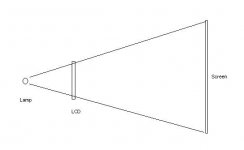I'm not an optics person, but started wondering about something.
If you have a lenseless system... just a lamp and a LCD, with a light cone between the two to prevent light with the wrong direction from coming in from an odd angle and ruining the image, what would be the result?
Seems to me that the image size projected would be directly related to how far away the lamp was from the lcd image.
Thus using basic geometry, you can build a simple projector for a specific room very cheaply without lenses.
Am I mistaken, or would this not really work? After all, a lens just bends the light, which doesn't seem necessary in a direct projection system like this.
If you have a lenseless system... just a lamp and a LCD, with a light cone between the two to prevent light with the wrong direction from coming in from an odd angle and ruining the image, what would be the result?
Seems to me that the image size projected would be directly related to how far away the lamp was from the lcd image.
Thus using basic geometry, you can build a simple projector for a specific room very cheaply without lenses.
Am I mistaken, or would this not really work? After all, a lens just bends the light, which doesn't seem necessary in a direct projection system like this.
Attachments
like the batman sign on the sky.
if you can make a true point light source, it will work. but true point light sources do not exist. you will project a batman sign or whatever sign on the wall without problem using your setup. problem is we want higher resolution.
if you can make a true point light source, it will work. but true point light sources do not exist. you will project a batman sign or whatever sign on the wall without problem using your setup. problem is we want higher resolution.
No, sorry, it won't work since the light diffuses when it passes through the lcd. Light-rays passing through one of the pixels will break into several rays in different directions. You need to focus those rays with a projection lense to get a picture.
For the LCD, picture a giant pile of straws. Only parallel light passes through it without distortion. This is similar to how the polarizers on an LCD work.
You need the light coming in perpendicular to the surface, and for that, you need a collimator fresnel.
Then, since the light has been collimated, the image would appear on your wall as a 15" image, regardless of distance (well, you add distortion since the light isn't PERFECTLY collimated). So you need a field fresnel to make the beam back into something that will get bigger with distance.
You need the light coming in perpendicular to the surface, and for that, you need a collimator fresnel.
Then, since the light has been collimated, the image would appear on your wall as a 15" image, regardless of distance (well, you add distortion since the light isn't PERFECTLY collimated). So you need a field fresnel to make the beam back into something that will get bigger with distance.
Actually even columized light will get diffracted resulting in diffraction patterns on the screen. Luckily the mechanics of how lcds produce pictures are very different from a pile of straws.
LOL! 😀 That was exactly what I thought of when I read the post subject!Duo said:Hmm, I'm envisioning pinhole lenses and megawatt lighting?
If you have a point source of light, and if LCDs didn't have all those nasty polar effects it certainly could work.
Unfortunately, we don't have point sources of light. We have bulb with filaments and arcs which can be small, but are definitely not point sources.
And LCDs do have those nasty polar effects. They have to, because that's how they work.
Anyone else notice how in movies and TV a person sitting in front of a computer monitor in a dark room has the image from the monitor projected onto their face? Often with perfectly readable text? (Occasionally it's even mirror imaged!) If only real life were that easy!
- Status
- Not open for further replies.
- Home
- General Interest
- Everything Else
- The Moving Image
- DIY Projectors
- Lenseless projector?
